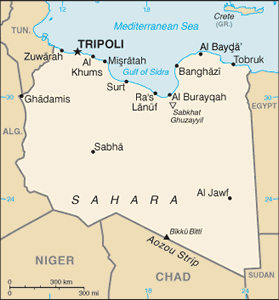The Geography of Libya
The Geography of Libya
Libyan Geography
Location: Northern Africa, bordering the Mediterranean Sea, between Egypt and Tunisia
Geographic coordinates: 25 00 N, 17 00 E
Map references: Africa
Area: total: 1,759,540 sq km land: 1,759,540 sq km water: 0 sq km
Area - comparative: slightly larger than Alaska
Land boundaries: total: 4,348 km border countries: Algeria 982 km, Chad 1,055 km, Egypt 1,115 km, Niger 354 km, Sudan 383 km, Tunisia 459 km
Coastline: 1,770 km
Maritime claims: territorial sea: 12 nm note: Gulf of Sidra closing line - 32 degrees, 30 minutes north exclusive fishing zone: 62 nm
Climate: Mediterranean along coast; dry, extreme desert interior
Terrain: mostly barren, flat to undulating plains, plateaus, depressions
Elevation extremes: lowest point: Sabkhat Ghuzayyil -47 m highest point: Bikku Bitti 2,267 m
Natural resources: petroleum, natural gas, gypsum
Land use: arable land: 1.03% permanent crops: 0.19% other: 98.78% (2005)
Irrigated land: 4,700 sq km (2003)
Natural hazards: hot, dry, dust-laden ghibli is a southern wind lasting one to four days in spring and fall; dust storms, sandstorms
Environment - current issues: desertification; limited natural fresh water resources; the Great Manmade River Project, the largest water development scheme in the world, is being built to bring water from large aquifers under the Sahara to coastal cities
Environment - international agreements: party to: Biodiversity, Climate Change, Climate Change-Kyoto Protocol, Desertification, Endangered Species, Hazardous Wastes, Marine Dumping, Ozone Layer Protection, Ship Pollution, Wetlands signed, but not ratified: Law of the Sea
Geography - note: more than 90% of the country is desert or semidesert


